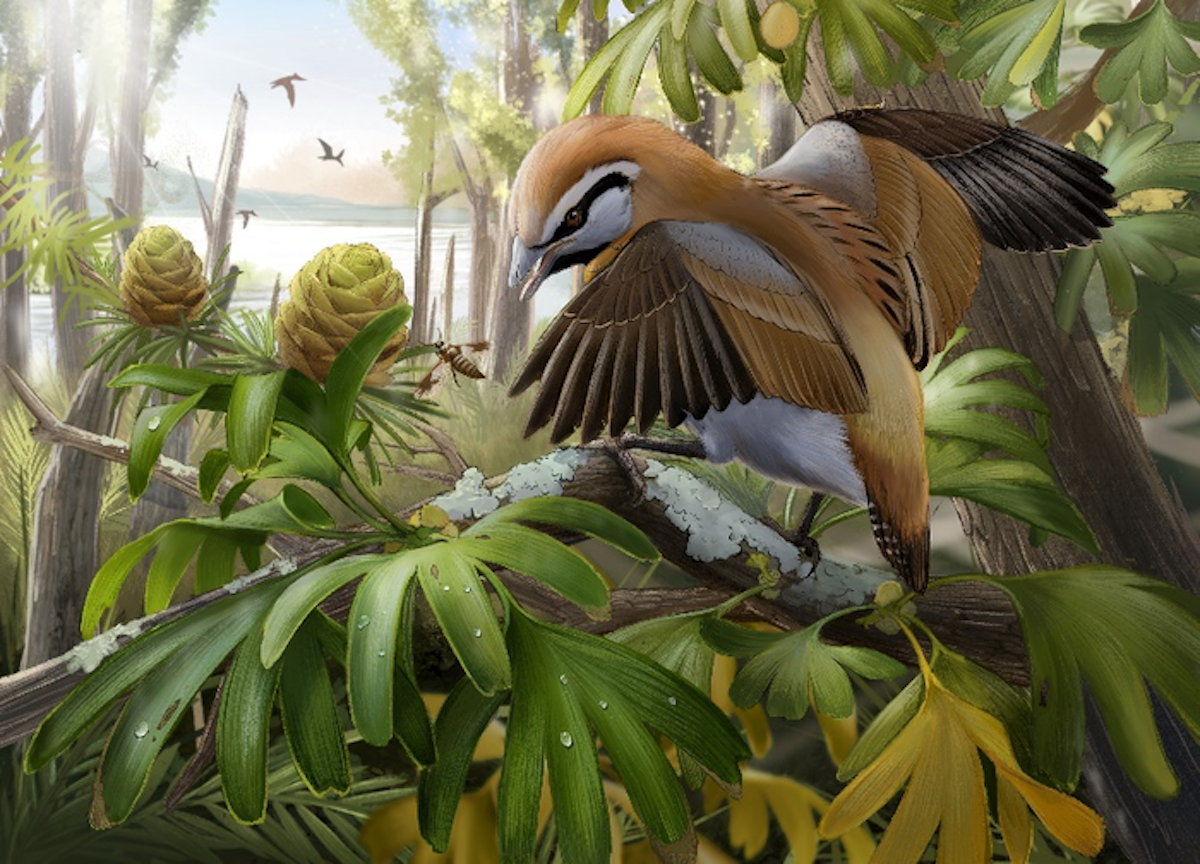

Around 120 million years ago in what is now northeastern China, there lived a bird that may have possessed the unusual ability to stick its tongue out.
Scientists described a nearly complete skeleton of the ancient bird, which they named Brevirostruavis macrohyoideus, on December 1 in the Journal of Anatomy. The fossil’s extremely elongated tongue attachment bones, or hyoid apparatus, suggests that the bird could protrude its tongue from its mouth, much as some present-day birds do to grab hard-to-reach morsels.
Brevirostruavis highlights how both modern birds and their extinct relatives have developed a plethora of ways to secure a meal, says Robert Kambic, an assistant professor of biology at Hood College in Frederick, Maryland, who was not involved with the research.
“Birds were evolutionarily experimenting with a bunch of different types of feeding adaptations and strategies early on,” he says. “That’s just a cool thing, that this diversity of habits and feeding modes is not unique to living birds, but in fact seems to be representative of the whole bird line.”
In humans, the U-shaped hyoid sits at the base of the tongue, just above the voicebox. “That bone is not attached to any other bone, and it’s floating suspended by muscles that attach to it from a bunch of different directions,” Kambic says. “Some of the muscles of the tongue need this anchor point, especially if you think about sticking your tongue out and retracting it.”

Birds typically lack the muscular, agile tongues enjoyed by humans, although a few do have fleshy tongues that help them peel fruits or seeds with their beaks. And in a few families, parts of the hyoid apparatus and beak are elongated, allowing the birds to poke their tongues out. Hummingbirds use their nimble tongues to slurp up nectar from deep within flowers, while woodpeckers extend their tongues to pull insects or sap from trees.
“Woodpeckers are the extreme,” Zhiheng Li, a paleontologist at the Chinese Academy of Sciences in Beijing and coauthor of the findings, said in an email. “Their tongues are so long that they actually wrap around the top of their heads and even enter one of their nostrils.”

The newly-reported Brevirostruavis belongs to a diverse group of early birds called Enantiornithes, which have no living representatives but were the dominant birds around the world during the Cretaceous Period. The specimen was discovered preserved in a slab of rock from China’s Liaoning Province dating to the early Cretaceous. Brevirostruavis was about the size of a starling, and its long claws and the proportions of its toe bones hint that the creature was a tree-dweller.
When the researchers examined the Brevirostruavis fossil, they also identified an odd combination of features not seen in other living or extinct birds.
In today’s birds, the hyoid apparatus consists of cartilage and several bones, including the rod-shaped ceratobranchials and epibranchials. Modern birds that can stick their tongues out have especially long epibranchial bones, as well as elongated beaks. Early birds didn’t have these bones; in Brevirostruavis, it’s the ceratobranchials that are curved and run nearly the length of its skull.

More perplexingly, Brevirostruavis also had a short, pointed snout, which was lined with peg-shaped teeth. This unique pairing—a very long hyoid apparatus and short snout—could have several explanations, Kambic says.
“Rather than trying to get the tongue as far out as it can, the long muscle attachment could also be good for a muscular tongue that’s really needed…to either maneuver food around within the mouth or close to the mouth,” he speculates.
Another possibility is that Brevirostruavis did indeed use its impressive hyoid to stick its tongue out, but some evolutionary constraint prevented the bird from elongating its beaklike snout. “So it has this long tongue without a commensurate beak to help it out,” Kambic says. “It has one part of the system, whereas a living bird might have two parts of the system that would work together.”
[Related: Were rocks on the menu for these ancient birds?]
Brevirostruavis may have been able to take advantage of food sources that other birds were unable to access, although the lack of preserved remains from the specimen’s last meal makes it difficult to be sure what it ate. Still, it’s possible that Brevirostruavis used its tongue to explore the bark of trees for hidden insects or to reach the nectar-like fluids and seeds in the reproductive cones of prehistoric plants, Li said.
The team also analyzed the evolutionary relationships between Brevirostruavis and its relatives. They found that Brevirostruavis didn’t fit with any of the major groups of enantiornithines, indicating that the elongated hyoid apparatus evolved independently multiple times across the bird family tree.
“Many of the same problems related to flying and eating today were present 120 million years ago, and that is why we see some of the same features evolved in such distant relatives of the birds around us today,” Li said.
Next, the team plans to examine several other fossil birds that also seem to have had fairly long tongues and to search for more Brevirostruavis specimens. “We also want to see if we can determine when the epibranchial bones evolved in birds, because those bones are pivotal for the long tongues present in living birds,” Li said.

Investigating how modern birds use their hyoid apparatuses might also shed light on why Brevirostruavis evolved its unusual combination of a short snout and long tongue bones, says Kambic, who studies how bones and muscle work together in living animals.
Nonetheless, he says, much can be learned from the skulls and tongue bones of bygone animals like Brevirostruavis.
“[They] can potentially give us some nice specific insights in terms of what these animals were eating,” Kambic says. “And that gives us information about their day-to-day lives in a more direct way than some of the other bones of the rest of the body might be able to tell us.”